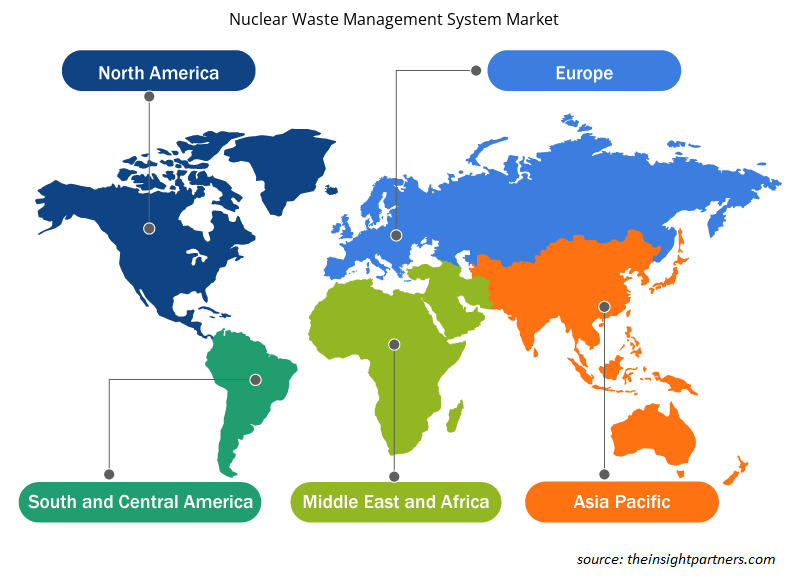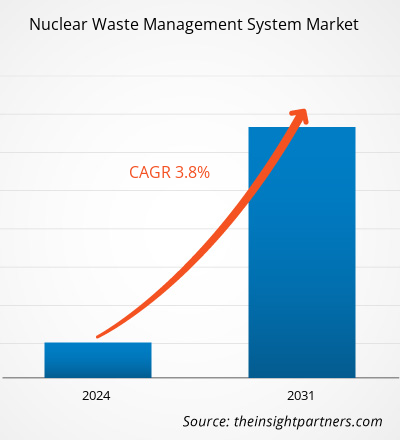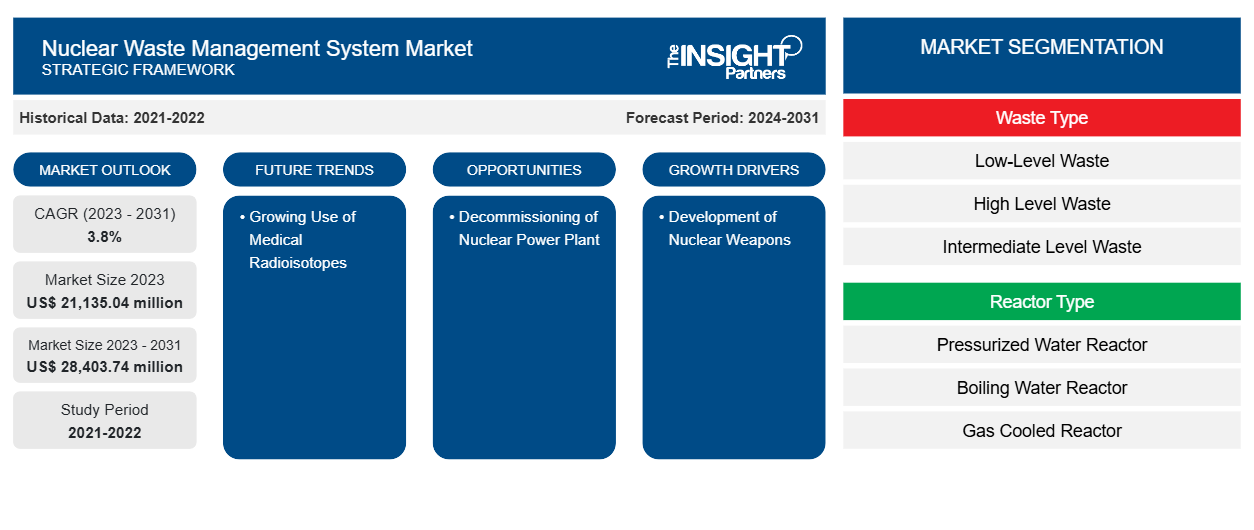Der Markt für nukleare Abfallmanagementsysteme soll von 21.135,04 Millionen US-Dollar im Jahr 2023 auf 28.403,74 Millionen US-Dollar im Jahr 2031 anwachsen. Der Markt wird voraussichtlich zwischen 2023 und 2031 eine durchschnittliche jährliche Wachstumsrate von 3,8 % verzeichnen. Der Energiebedarf steigt aufgrund der steigenden Bevölkerungszahl und der Urbanisierung weltweit, gepaart mit der zunehmenden Industrialisierung, und wird wahrscheinlich ein wichtiger Markttrend für nukleare Abfallmanagementsysteme bleiben.
Marktanalyse für nukleare Abfallbeseitigungssysteme
Der Markt für Entsorgungssysteme für Atommüll wächst derzeit stark, da aufgrund des steigenden Bedarfs an sauberer Energie weltweit immer mehr Atomkraftwerke gebaut werden. Die hohen Kosten für Entsorgungssysteme für Atommüll bremsen das Marktwachstum jedoch. Augean Plc , Perma-Fix Environmental Services, Inc., Svensk Kärnbränslehantering AB, Ansaldo Energia , US Ecology, Inc., Veolia Environmental Services, Bechtel Corporation, EnergySolutions , BHI Energy und Waste Control Specialists, LLC gehören zu den Hauptakteuren auf dem globalen Markt für Entsorgungssysteme für Atommüll.
Marktübersicht für nukleare Abfallmanagementsysteme
Wichtige Interessenvertreter auf dem Markt für nukleare Abfallmanagementsysteme sind staatliche Regulierungsbehörden/Beratungsstellen, Dienstleister und Endnutzer. Die staatlichen Regulierungsbehörden/Beratungsstellen legen die Vorschriften für jede Branche fest und machen sie aufgrund zunehmender Umweltbedenken zur Pflicht. Endnutzer von nuklearen Abfallmanagementsystemen sind verschiedene Branchen, die große Mengen radioaktiven Abfalls erzeugen, der die Umwelt belastet, wie beispielsweise Kernkraftwerke , biomedizinische Geräte und Atomwaffen. Die Verwendung von Radioisotopen in verschiedenen Diagnoseverfahren ist weltweit zu einer gängigen Praxis geworden. Das Radioisotop wird in Kernreaktoren oder Zyklotronen hergestellt; außerdem müssen neutronenreiche Isotope und solche, die durch Kernspaltung entstehen, in Reaktoren hergestellt werden. Daher wird erwartet, dass der zunehmende Einsatz von Nuklearmedizin in der Gesundheitsbranche den Markt für nukleare Abfallmanagementsysteme in der kommenden Zukunft ankurbeln wird.
Passen Sie diesen Bericht Ihren Anforderungen an
Sie erhalten kostenlos individuelle Anpassungen an jedem Bericht, einschließlich Teilen dieses Berichts oder einer Analyse auf Länderebene, eines Excel-Datenpakets sowie tolle Angebote und Rabatte für Start-ups und Universitäten.
-
Holen Sie sich die wichtigsten Markttrends aus diesem Bericht.Dieses KOSTENLOSE Beispiel umfasst eine Datenanalyse von Markttrends bis hin zu Schätzungen und Prognosen.
Markttreiber und Chancen für nukleare Abfallmanagementsysteme
Entwicklung von Atomwaffen treibt Nachfrage nach Entsorgungssystemen für Atommüll
Zunehmende Bedenken im Zusammenhang mit der nationalen Sicherheit veranlassen Regierungen auf der ganzen Welt dazu, mehr Mittel für Militärbudgets bereitzustellen. Um die Verteidigungskräfte zu stärken, entwickeln Länder wie die USA, China, Russland, Frankreich, Großbritannien, Indien, Israel, Südkorea und der Iran Atomwaffen. Bei der Entwicklung und Demontage von Atomwaffen entsteht genügend schwach- und mittelradioaktiver Atommüll. Daher fördert die zunehmende Entwicklung und Demontage von Atomwaffen das Wachstum des Marktes für nukleare Abfallmanagementsysteme.
Stilllegung von Kernkraftwerken – eine Chance auf dem Markt für nukleare Abfallmanagementsysteme
Normalerweise beträgt die Lebensdauer eines Kernkraftwerks 20–40 Jahre. Viele Kernkraftwerke erreichen jetzt das Ende ihrer Lebensdauer. Darüber hinaus werden Sicherheitsbedenken aufgrund des politischen und gesellschaftlichen Widerstands gegen die Abschaltung dieser Anlagen voraussichtlich die Stilllegung von Kernkraftwerken vorantreiben. Schätzungen zufolge werden bis Ende 2040 75 Kernkraftwerke und 33 Forschungsreaktoren in Amerika, 141 Kernkraftwerke und 64 Forschungsreaktoren in Europa, 77 Kernkraftwerke und 17 Forschungsreaktoren im asiatisch-pazifischen Raum sowie 2 Kernkraftwerke und 2 Forschungsreaktoren in Afrika und Australien stillgelegt sein. Daher wird erwartet, dass die Stilllegung von Kernkraftwerken auf der ganzen Welt in den kommenden Jahren lukrative Wachstumschancen für die Akteure auf dem Markt für nukleare Abfallbeseitigungssysteme schaffen wird.
Segmentierungsanalyse des Marktberichts zum Management nuklearer Abfälle
Wichtige Segmente, die zur Ableitung der Marktanalyse für nukleare Abfallmanagementsysteme beigetragen haben, sind Abfallart, Reaktortyp und Entsorgungsoptionen.
- Basierend auf der Abfallart wurde der Markt für nukleare Abfallmanagementsysteme in schwach radioaktive Abfälle, hoch radioaktive Abfälle, mittel radioaktive Abfälle und andere unterteilt. Das Segment schwach radioaktive Abfälle hatte im Jahr 2023 einen größeren Marktanteil.
- In Bezug auf den Reaktortyp wurde der Markt in Druckwasserreaktoren, Siedewasserreaktoren und gasgekühlte Reaktoren segmentiert. Das Segment der Druckwasserreaktoren dominierte den Markt im Jahr 2023.
- In Bezug auf die Entsorgungsoptionen wurde der Markt in oberflächennahe Entsorgung und tiefe geologische Entsorgung segmentiert. Das Segment der oberflächennahen Entsorgung dominierte den Markt im Jahr 2023.
Marktanteilsanalyse für nukleare Abfallentsorgungssysteme nach geografischer Lage
Der geografische Umfang des Marktberichts zu nuklearen Abfallmanagementsystemen ist hauptsächlich in fünf Regionen unterteilt: Nordamerika, Asien-Pazifik, Europa, Naher Osten und Afrika sowie Südamerika/Süd- und Mittelamerika.
Der Markt für nukleare Abfallmanagementsysteme in Nordamerika ist in die USA, Kanada und Mexiko unterteilt. Mehrere inländische und internationale Unternehmen haben in dieser Region eine starke Position. Die USA halten einen großen Anteil am Markt für nukleare Abfallmanagementsysteme in Nordamerika, gefolgt von Kanada und Mexiko. Nordamerika hat eine starke Neigung zur Kernenergie, und die USA und Kanada konzentrieren sich derzeit auf die Verlängerung der Lebensdauer von Kernkraftwerken und erkunden gleichzeitig potenzielle Optionen für die Entwicklung kleiner modularer Reaktoren in der Region. Die USA verfügen über die weltweit größte Flotte von Kernkraftreaktoren, die etwa 20 % des Strombedarfs des Landes decken.
Darüber hinaus gibt es in Nordamerika auch verschiedene Forschungseinrichtungen, die sich auf nukleare F&E-Aktivitäten spezialisiert haben. Der starke Gesundheitssektor fördert auch das Wachstum der Nuklearmedizin und Radiologie in Nordamerika. All diese Faktoren schaffen also reichlich Möglichkeiten für das Wachstum der Marktteilnehmer im Bereich nuklearer Abfallmanagementsysteme in der Region.
Regionale Einblicke in den Markt für nukleare Abfallmanagementsysteme
Die regionalen Trends und Faktoren, die den Markt für nukleare Abfallmanagementsysteme während des gesamten Prognosezeitraums beeinflussen, wurden von den Analysten von Insight Partners ausführlich erläutert. In diesem Abschnitt werden auch Marktsegmente und Geografien für nukleare Abfallmanagementsysteme in Nordamerika, Europa, im asiatisch-pazifischen Raum, im Nahen Osten und Afrika sowie in Süd- und Mittelamerika erörtert.

- Erhalten Sie regionale Daten zum Markt für nukleare Abfallentsorgungssysteme
Umfang des Marktberichts zum Management nuklearer Abfälle
| Berichtsattribut | Details |
|---|---|
| Marktgröße im Jahr 2023 | 21.135,04 Millionen US-Dollar |
| Marktgröße bis 2031 | 28.403,74 Millionen US-Dollar |
| Globale CAGR (2023 - 2031) | 3,8 % |
| Historische Daten | 2021-2022 |
| Prognosezeitraum | 2024–2031 |
| Abgedeckte Segmente |
Nach Abfallart
|
| Abgedeckte Regionen und Länder |
Nordamerika
|
| Marktführer und wichtige Unternehmensprofile |
|
Marktteilnehmerdichte: Der Einfluss auf die Geschäftsdynamik
Der Markt für nukleare Abfallmanagementsysteme wächst rasant, angetrieben durch die steigende Nachfrage der Endnutzer aufgrund von Faktoren wie sich entwickelnden Verbraucherpräferenzen, technologischen Fortschritten und einem größeren Bewusstsein für die Vorteile des Produkts. Mit steigender Nachfrage erweitern Unternehmen ihr Angebot, entwickeln Innovationen, um die Bedürfnisse der Verbraucher zu erfüllen, und nutzen neue Trends, was das Marktwachstum weiter ankurbelt.
Die Marktteilnehmerdichte bezieht sich auf die Verteilung der Firmen oder Unternehmen, die in einem bestimmten Markt oder einer bestimmten Branche tätig sind. Sie gibt an, wie viele Wettbewerber (Marktteilnehmer) in einem bestimmten Marktraum im Verhältnis zu seiner Größe oder seinem gesamten Marktwert präsent sind.
Die wichtigsten auf dem Markt für nukleare Abfallmanagementsysteme tätigen Unternehmen sind:
- Augean Plc
- Perma-Fix Umweltdienste, Inc.
- Svensk Kärnbränslehantering AB
- Ansaldo Energie
- Republic Services, Inc.
- Veolia Umweltdienste
Haftungsausschluss : Die oben aufgeführten Unternehmen sind nicht in einer bestimmten Reihenfolge aufgeführt.

- Überblick über die wichtigsten Akteure auf dem Markt für nukleare Abfallentsorgungssysteme
Marktnachrichten und aktuelle Entwicklungen zum Managementsystem für nukleare Abfälle
Der Markt für nukleare Abfallmanagementsysteme wird durch die Erfassung qualitativer und quantitativer Daten nach Primär- und Sekundärforschung bewertet, die wichtige Unternehmensveröffentlichungen, Verbandsdaten und Datenbanken umfasst. Im Folgenden finden Sie eine Liste der Entwicklungen auf dem Markt für Innovationen, Geschäftserweiterungen und Strategien:
- Im März 2022 unterzeichneten Perma-Fix Environmental Services, Inc. und Westinghouse Electric Company gemeinsam auf den Waste Management Symposia 2022 einen Vertrag und planen die Entwicklung einer Anlage zur fortschrittlichen Materialbehandlung in Großbritannien. (Quelle: Perma-Fix Environmental Services, Inc., Pressemitteilung/Unternehmenswebsite/Newsletter)
- Im Dezember 2023 schloss sich Veolia Nuclear Solutions mit Siteflow zusammen, um das Design und die Funktionalität seiner ferngesteuerten Systeme in der Nuklearindustrie und anderen Gefahrenumgebungen zu verbessern. (Quelle: Veolia Nuclear Solutions, Pressemitteilung/Unternehmenswebsite/Newsletter)
Marktbericht zu Entsorgungssystemen für nukleare Abfälle – Umfang und Ergebnisse
Der Bericht „Marktgröße und Prognose für nukleare Abfallmanagementsysteme (2021–2031)“ bietet eine detaillierte Analyse des Marktes, die die folgenden Bereiche abdeckt:
- Marktgröße und Prognose für nukleare Abfallentsorgungssysteme auf globaler, regionaler und Länderebene für alle wichtigen Marktsegmente, die in den Geltungsbereich fallen
- Marktdynamik wie Treiber, Beschränkungen und wichtige Chancen
- Markttrends für nukleare Abfallmanagementsysteme
- Detaillierte PEST- und SWOT-Analyse
- Marktanalyse für nukleare Abfallmanagementsysteme, die wichtige Markttrends, globale und regionale Rahmenbedingungen, wichtige Akteure, Vorschriften und aktuelle Marktentwicklungen umfasst
- Nukleare Abfallmanagementsystem-Industrie, Landschafts- und Wettbewerbsanalyse, einschließlich Marktkonzentration, Heatmap-Analyse, prominenten Akteuren und jüngsten Entwicklungen
- Detaillierte Firmenprofile
- Historische Analyse (2 Jahre), Basisjahr, Prognose (7 Jahre) mit CAGR
- PEST- und SWOT-Analyse
- Marktgröße Wert/Volumen – Global, Regional, Land
- Branchen- und Wettbewerbslandschaft
- Excel-Datensatz
Aktuelle Berichte
Verwandte Berichte
Erfahrungsberichte
Grund zum Kauf
- Fundierte Entscheidungsfindung
- Marktdynamik verstehen
- Wettbewerbsanalyse
- Kundeneinblicke
- Marktprognosen
- Risikominimierung
- Strategische Planung
- Investitionsbegründung
- Identifizierung neuer Märkte
- Verbesserung von Marketingstrategien
- Steigerung der Betriebseffizienz
- Anpassung an regulatorische Trends























 Kostenlose Probe anfordern für - Markt für nukleare Abfallmanagementsysteme
Kostenlose Probe anfordern für - Markt für nukleare Abfallmanagementsysteme